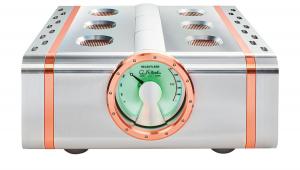Leema Acoustics Neutron/Graviton Pre/Power Amplifier Lab Report
Leema Acoustics Neutron
In practice, Leema's 120-step volume control (–96 to +24) operates in ±1dB increments over a 110dB range (–90 to +21), offering a maximum gain of +32.3dB (balanced i/o) and a maximum output of 18.2V from a 25ohm source impedance. There is some variation in HF response with volume position (–0.6dB/20kHz at +21) but the Neutron achieves ±0.01dB from 20Hz-20kHz below '00' on the display before rolling very gently away to –0.25dB/100kHz. Noise is low, though not vanishingly so, and the 89dB A-wtd S/N (re. 0dBV) is good enough bearing in mind the spurious tone detected during the DAC tests [next paragraph]. Distortion also varies with both level and frequency, falling to 0.00006-0.0004% at 0dBV (20Hz-20kHz) with the lowest THD achieved at low bass frequencies rather than the midband, which is more typical.
Used as a DAC/preamp, the Neutron's balanced output clips beyond volume position '00' (16.2V) with 0dBFs inputs, although the control is unlikely to be advanced to this point in practice! Tested at volume position '–17' (2V at 0dBFs), distortion is a moderate 0.0011-0.015% (re. 20Hz-20kHz) but there is evidence of truncation below –100dBFs at 1kHz and –80dBFs at 20kHz [see Graph 1, below]. As indicated earlier, the A-wtd S/N is limited to 86dB because of a spurious tone detected at 10.2kHz some 45dB above the noise floor. Without this the S/N ratio would be closer to 91dB as PSU noise becomes the dominant factor – the tone is clearly visible in the jitter plot [see Graph 2] which, to the Neutron's credit, is otherwise clear of correlated sidebands (<20psec, all sample rates). Finally, the responses reach out to –0.25dB/20kHz, –1.7dB/45kHz and –4.7dB/90kHz with 48kHz, 96kHz and 192kHz media, respectively. PM


| Maximum output / Impedance | 18.2V / 25ohm (balanced) |
| Input sensitivity (re. 0dBV) | 23mV (balanced) |
| Freq. resp. (20Hz-20kHz/100kHz) | +0.0 to –0.01dB/–0.45dB (pre) |
| Freq. resp. (20Hz-20k/45k/90kHz) | +0.0 to –0.3dB/–1.7dB/–4.7dB (DAC) |
| Digital jitter (USB at 48kHz/96kHz) | <5psec / 20psec |
| A-wtd S/N ratio (re. 0dBV/0dBFs) | 89.1dB (Analogue) / 86.0dB (Dig) |
| Distortion (20Hz-20kHz; 0dBV/0dBFs) | 0.00006-0.0004% / 0.0011-0.015% |
| Power consumption | 9W (1W standby) |
| Dimensions (WHD) / Weight | 440x109x325mm / 5kg |
Leema Acoustics Graviton
When reviewing/testing pre/power combinations we do not always discover a 'star product' among the pair, but if there's a standout here then it's most certainly the Graviton. For starters, Leema is quite cautious in rating the amplifier for very low impedance loads, citing a 'minimum 4ohm impedance'. This does the Graviton an injustice for while its rated 150W/8ohm and 260W/4ohm is matched on the bench at 2x165W and 2x285W, respectively, there's plenty of headroom in that huge PSU to support 198W, 371W and 660W into 8, 4 and 2ohm loads under dynamic conditions followed by a full 1kW (31.7A) into the lowest 1ohm loads [see Graph 1, below]. So the Graviton will not be intimidated by insensitive speakers or those with 'tough' sub-4ohm loads. There's some hum from the PSU (not unlike the Neutron – see p73) that punches through to limit the A-wtd S/N to 85dB (re. 0dBW), but this is 'average' rather than debilitating and does not compromise either separation (90dB/100Hz) or damping (0.038ohm/20Hz) at low frequencies.
Distortion is low, rising gently with power output from 0.0013%/1W to 0.0025%/10W, 0.012%/100W and 0.016% at the rated 150W (all 1kHz/8ohm). Versus frequency, distortion is also very well controlled increasing, as expected, at HF but only marginally from 0.009%/1W to 0.011%/10W and 0.06%/100W [all re. 20kHz – see Graph 2]. The response is gently tailored at very low and high frequencies, with –3dB points at 2Hz and 90kHz, rolling away very slightly at –0.35dB/20kHz/8ohm and –1.0dB/20kHz/1ohm. Finally, overall gain is sensibly restricted to +25.2dB (balanced XLR in) requiring 155mV for 1W/8ohm and a little under 2V to raise the rated 150W/8ohm output. PM


| Power output (<1% THD, 8/4ohm) | 165W / 285W |
| Dynamic power (<1% THD, 8/4/2/1ohm) | 198W / 371W / 660W / 1003W |
| Output imp. (20Hz–20kHz/100kHz) | 0.038-0.12ohm / 0.75ohm |
| Frequency resp. (20Hz–20kHz/100kHz) | –0.3dB to –0.28dB / –3.7dB |
| Input sensitivity (for 0dBW/150W) | 155mV / 1940mV |
| A-wtd S/N ratio (re. 0dBW/150W) | 85.4dB / 107.2dB |
| Distortion (20Hz-20kHz, 10W/8ohm) | 0.0015-0.011% |
| Power consumption (Idle/Rated o/p) | 53W / 475W (4W standby) |
| Dimensions (WHD) / Weight | 338x109x335mm / 16kg |
| Prices | £1500 each (£2800 as a pair) |























































